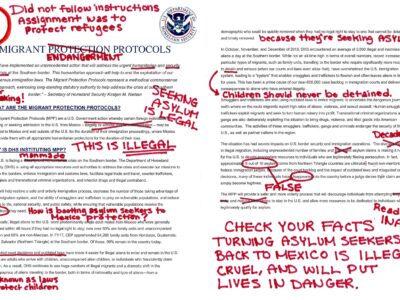In-Country Refugee Processing for At-Risk Children in Central America: Potential Benefits and Risks
This week the President authorized “in-country” resettlement from El Salvador, Honduras and Guatemala. This step will allow the United States to bring to the country, through its formal resettlement program, a small number of people who face persecution that meets the “refugee” standards under U.S. law. The special authorization permits their resettlement even though they aren’t technically “refugees,” as they haven’t yet fled their home countries.
The President’s Report to Congress on Proposed Refugee Admissions for Fiscal Year 2015, which was just publicly released, states that this in-country program would enable some lawfully present relatives in the United States to request resettlement for children still residing in their home countries and eligible for admission as refugees. It also states that “[d]ecisions on several program parameters are still being considered by the Departments of State and Homeland Security and will be briefed to Congress before the program is implemented.”
The numbers though will likely be quite modest. Only 4000 resettlement slots are allocated to the entire Latin America and Caribbean region, and several thousand of those slots are typically used to resettle Cubans each year.
In-country resettlement processing has the potential to save lives, but it is also a process fraught with risks – both for the individual in need of protection and the broader refugee protection system. An effective and timely in-country processing initiative could bring some persecuted children to safety in the United States, in some cases reuniting them with parents living here. This would spare the children the dangers of the difficult journey.
There is no question that U.S. in-country processing helped save the lives of some Iraqis who faced threats and violence because of their work with the United States. This processing allowed some to wait in Iraq while their U.S. protection applications were processed, rather than risking the dangerous journey out of the country.
But the delays in resettlement processing mean that those who seek protection through in-country processing remain at risk while they wait—sometimes for months, sometimes for much longer. Human Rights First issued reports in 2009 and 2010 detailing the processing delays affecting Iraqi refugees and special immigrant visa applicants. Groups that help U.S. affiliated Iraqis have reported that some have been killed and threatened while waiting. When in-country processing was used for Haitians in the 1990s, as Bill Frelick has pointed out, Haitian applicants were beaten and arrested by Haitian police and paramilitary forces while waiting in line for U.S. processing in Port-au-Prince.
Any programs for Central American children will need to move quickly, so that children who are facing imminent risks at the hands of violent gangs or other persecutors are not left in dangerous circumstances while they await the completion of their processing. The U.S. State Department should work with the UN Refugee Agency (UNHCR) and local NGOs to employ other protection mechanisms such as emergency transit centers, evacuation or parole as well as safe shelter. Any in-country program should be part of a broader effort to enhance protection throughout the region. Practically speaking, the program will need to actually extend protection in a timely manner to a meaningful number of applicants if it is to be viewed as a credible alternative to some families with at-risk children.
In-country processing, if not properly managed and messaged, can also undermine the broader refugee protection system. The United States has used in-country processing as a tool to encourage asylum seekers to return to their country of feared persecution, telling Cubans interdicted at sea, for example, that they can return to Havana to seek U.S. protection. At times, it has also been misused, with U.S. officers pointing to the existence of in-country resettlement from Haiti to limit access to protection despite the universal right to seek asylum, U.S. obligations under the Refugee Convention and Protocol, and the fact that in-country processing is never actually available, or a viable protection option, for many who have very legitimate and well-founded fears of persecution.
Any in-country system must be accompanied by safeguards to ensure that U.S. policymakers or adjudicators do not attempt to limit access to asylum by pointing to the existence of in-country processing. And U.S. leaders, in their public statements referencing any in-country program, must also be careful not to send the wrong message to U.S. asylum adjudicators at home. In-country processing has been most successful in cases, such as in Iraq, where it has been viewed as a more easily accessible protection route rather than a ploy to limit asylum.

